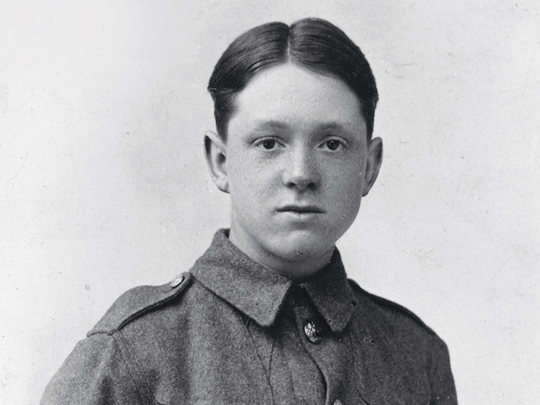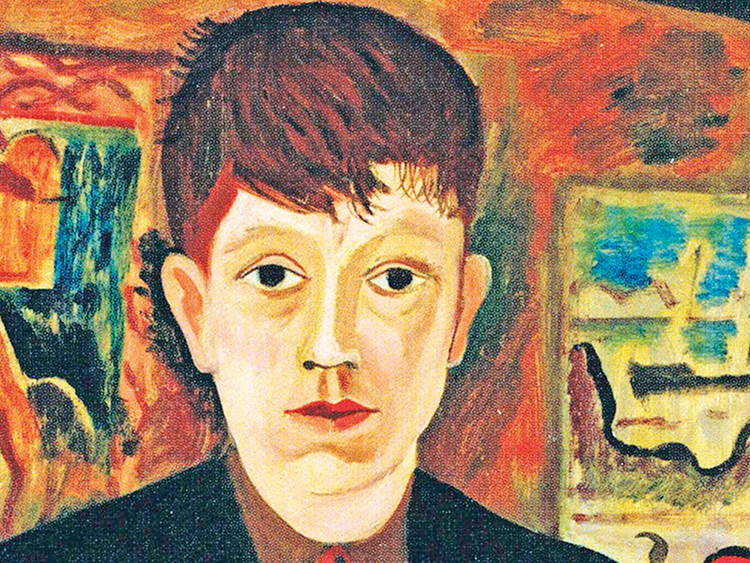
David Jones: Engraver, Soldier, Painter, Poet
By Thomas Dilworth, Jonathan Cape, 448 pages, $39.50
It is rare to read a major biography of a minor figure, but then David Jones, an artist who produced outstanding and original work in several media, primarily poetry and painting, is minor by mistake. To prove it, Thomas Dilworth, who has written two other books on Jones’s life and work in the 30 years since he was commissioned to write this one, begins with an enfilade of praise from TS Eliot, WH Auden, Kenneth Clark, Graham Greene, Seamus Heaney, Igor Stravinsky and Dylan Thomas. The effect is to make the reader wonder how someone possessed of such genius could become so obscure. “If Beckett was the last great modernist,” he writes, “Jones was the lost great modernist.”
In his introduction to In Parenthesis, one of Jones’s two brilliant long poems, TS Eliot put him at the heart of Anglophone modernism by including him in a quartet with “ Joyce and Pound and myself”. He was born into a working-class family in Brockley, south London, in 1895, his father Welsh and mother English. Artistically precocious, he was studying art at Camberwell when the First World War began, and enlisted in January 1915 with the Royal Welch Fusiliers. He described himself as “a parade’s despair”, but was, Dilworth notes, not a bad soldier: “canny, efficient” and “adept at survival”. In 1916, he was shot in the leg at Mametz Wood, an engagement in the battle of the Somme, and didn’t return to the front.
Jones went back to art school for a few years, suffered a minor breakdown in 1921, and in 1922 joined Eric Gill ‘s community of Catholic craftsmen in Sussex. Raised Anglican and always serious about religion, he had converted to Catholicism in 1921. The centrality of religion to Jones’s work offers a clue to his obscurity: one of his greatest influences is the Catholic mass, which he saw as the highest achievement of western culture. As Basil Bunting said of The Anathemata - the 1952 book-length poem that most hardcore Jonesians consider his masterpiece, as did Jones himself - he “made the mass a complex of symbols capable of ordering and interpreting pretty well the whole history of the world and the whole order of nature”. This, added to the line-by-line complexity of the poem - William Carlos Williams described it to Pound as “tough, but rewarding”, while Auden thought it required many rereadings and “a great deal of trouble” - is bound to discourage a significant number of modern readers. As Donald Carne-Ross put it in a 1980 essay, the problem is that the beliefs Jones “lived and wrote from are to many people now so remote as to be little more than nonsense. And yet you are probably not going to get far with his work, except for the formal interest of his technique, without taking his beliefs seriously and perhaps even allowing that he might just be right, at least some of the way”.
In Parenthesis is more approachable, although still essentially sacramental in conception. It blends infantryman demotic with a Shakespearean register, Christianity, Welsh legend, chivalric romance, a Joycean collapsing of past into present, Spenglerian cultural theory and the linguistic compactness of Gerard Manley Hopkins.
Dense with allusion, the text is sometimes a maze, but for all its darkness and difficulty it is also an extraordinarily beautiful, unforgettable reading experience. He began writing it in 1928, originally as text to accompany engravings depicting the war, but it kept growing, and his desire to turn it into a full-blown book was fed by his dissatisfaction with literary accounts of the conflict (“Bugger it, I can do better than that,” he exclaimed on finishing Erich Maria Remarque’s All Quiet on the Western Front ).
In these years, the early 1930s, Jones was “super productive”, producing a large number of extraordinary watercolours, which seem to writhe and shimmer on the paper, and filling hundreds of pages as he revised and added to In Parenthesis. This frenzy was interrupted in 1932 by his most serious breakdown. When a concerned friend asked him how he was, he murmured, “he’s really sending them over”, as if his depression were an enemy shelling his position.
Always prepared to look to the past, Jones hunted unsuccessfully for a diagnosis in Robert Burton’s 1621 book The Anatomy of Melancholy. Today his illness would almost certainly be considered PTSD. He experienced the daily horrors of frontline trench life, heavy shelling and terrifying night combat at Mametz Wood. After the 1932 breakdown, he moved back to his parents’ house, and for a year was almost completely incapacitated. He never fully recovered, writing in 1968 of this breakdown that “it has persisted”.
Jones’s depression - he christened it “Rosey” - would afflict him when he carried out any significant amount of artistic work, but he found ways around this psychological obstruction. First, he had a network of caring friends, who greatly valued his kindness, gentleness and the brilliance of his conversation. They stopped his perennial poverty becoming abject by buying his art, subscribing to a fund to provide him with an allowance, and often putting him up for long spells. Second, Doctor Stevenson, a psychiatrist who treated him from 1947, overturned previous medical advice that Jones should avoid creative work. His treatment, initially psychoanalytical, became largely pharmacological over time. By the early 1960s, Jones was taking a staggering amount of barbiturates and antidepressants, a blanket of drugs that, Dilworth convincingly asserts, smothered his creativity. After The Anathemata (1952) the next poetry collection didn’t appear until 1974, the year he died. What should have taken “at most” seven years, Dilworth mourns, took 20.
By the early 1960s, Jones was taking a staggering amount of barbiturates and antidepressants, smothering his creativity Jones’s painting was impeded too, although it came more easily than writing: “the ‘ideas’ in a painting are not so damned nailed down as in writing - words are buggers for that”. But in his case, the two disciplines were intertwined and inextricable. Writing about a 1940 painting, Guenever, Dilworth comments: “If, in the vividness of its images, In Parenthesis is a painter’s poem, this is a writer’s painting, bristling with explicit cultural referents and specific symbols.” Dilworth is a brilliant describer and analyst of the art; his descriptions would make individual works vivid to the reader even if they weren’t reproduced in this richly illustrated book.
On Jones’s writing, however, he is less successful. He sedulously notes technical details and identifies influences, but fails to bring the poems to life, or even back up his assertions about them. We are told a section from The Anathemata that Jones worried was purple is in fact “a lyrical high-point in modern literature”, and that The Hunt (1965) is one of the great modern English lyric poems, “lyrically musical and highly visual”, but without supporting quotations the praise feels empty.
This is the only serious flaw in a biography that compresses Dilworth’s encyclopedic knowledge of his subject into a fascinating narrative. It is a heroic attempt to salvage Jones for a new audience, reclaiming him from a past in which a critic in this paper felt able to call him “an eccentric figure on the periphery of English poetry”.
Will he succeed? I am doubtful. I have another book about Jones, written in 1988, whose editor felt confident that “we are now approaching a stage in the criticism of his writings and his visual art when it will no longer be necessary to rehearse the opinions of canonised authorities to gain attention for an uncanonised master whose works begin to appear, with time, the equal of their own”. Thirty years later, Dilworth still feels the need to begin his biography with Eliot, Auden and Heaney’s proclamations of Jones’s genius. If it doesn’t work this time, he might well remain the lost great modernist for ever.
–Guardian News & Media Ltd










